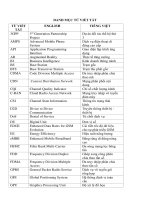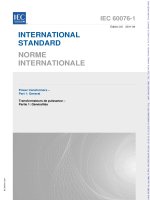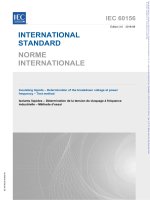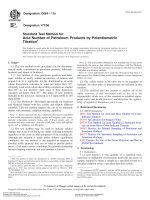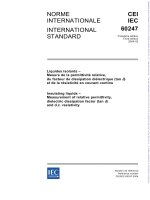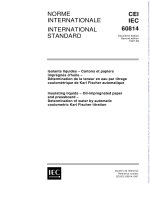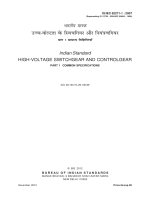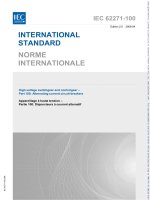tiêu chuẩn thí nghiệm astm C29 c29 m
Bạn đang xem bản rút gọn của tài liệu. Xem và tải ngay bản đầy đủ của tài liệu tại đây (42.18 KB, 4 trang )
Designation: C 29/C 29M – 97
American Association of State
Highway and Transportation Officials Standard
AASHTO No.: T19/T19M
Standard Test Method for
Bulk Density (“Unit Weight”) and Voids in Aggregate1
This standard is issued under the fixed designation C 29/C 29M; the number immediately following the designation indicates the year
of original adoption or, in the case of revision, the year of last revision. A number in parentheses indicates the year of last reapproval.
A superscript epsilon (e) indicates an editorial change since the last revision or reapproval.
This standard has been approved for use by agencies of the Department of Defense.
1. Scope
1.1 This test method covers the determination of bulk
density (“unit weight”) of aggregate in a compacted or loose
condition, and calculated voids between particles in fine,
coarse, or mixed aggregates based on the same determination.
This test method is applicable to aggregates not exceeding 5 in.
[125 mm] in nominal maximum size.
C 702 Practice for Reducing Samples of Aggregate to
Testing Size2
D 75 Practice for Sampling Aggregates3
D 123 Terminology Relating to Textiles4
E 11 Specification for Wire Cloth and Sieves for Testing
Purposes5
2.2 AASHTO Standard:
T19/T19M Method of Test for Unit Weight and Voids in
Aggregate6
NOTE 1—Unit weight is the traditional terminology used to describe the
property determined by this test method, which is weight per unit volume
(more correctly, mass per unit volume or density).
3. Terminology
3.1 Definitions—Definitions are in accordance with Terminology C 125 unless otherwise indicated.
3.1.1 bulk density, n—of aggregate, the mass of a unit
volume of bulk aggregate material, in which the volume
includes the volume of the individual particles and the volume
of the voids between the particles. Expressed in lb/ft3 [kg/m3].
3.1.2 unit weight, n—weight (mass) per unit volume. (Deprecated term–used preferred term bulk density.)
3.1.2.1 Discussion—Weight is equal to the mass of the body
multiplied by the acceleration due to gravity. Weight may be
expressed in absolute units (newtons, poundals) or in gravitational units (kgf, lbf), for example: on the surface of the earth,
a body with a mass of 1 kg has a weight of 1 kgf (approximately 9.81 N), or a body with a mass of 1 lb has a weight of
1 lbf (approximately 4.45 N or 32.2 poundals). Since weight is
equal to mass times the acceleration due to gravity, the weight
of a body will vary with the location where the weight is
determined, while the mass of the body remains constant. On
the surface of the earth, the force of gravity imparts to a body
that is free to fall an acceleration of approximately 9.81 m/s2
(32.2 ft/s2).
D 123.
3.2 Definitions of Terms Specific to This Standard:
3.2.1 voids, n—in unit volume of aggregate, the space
between particles in an aggregate mass not occupied by solid
mineral matter.
3.2.1.1 Discussion—Voids within particles, either permeable or impermeable, are not included in voids as determined
by this test method.
1.2 The values stated in either inch-pound units or SI units
are to be regarded separately as standard, as appropriate for a
specification with which this test method is used. An exception
is with regard to sieve sizes and nominal size of aggregate, in
which the SI values are the standard as stated in Specification
E 11. Within the text, SI units are shown in brackets. The
values stated in each system may not be exact equivalents;
therefore each system must be used independently of the other,
without combining values in any way.
1.3 This standard does not purport to address all of the
safety concerns, if any, associated with its use. It is the
responsibility of the user of this standard to establish appropriate safety and health practices and determine the applicability of regulatory limitations prior to use.
2. Referenced Documents
2.1 ASTM Standards:
C 125 Terminology Relating to Concrete and Concrete
Aggregates2
C 127 Test Method for Specific Gravity and Absorption of
Coarse Aggregate2
C 128 Test Method for Specific Gravity and Absorption of
Fine Aggregate2
C 138 Test Method for Unit Weight, Yield, and Air Content
(Gravimetric) of Concrete2
C 670 Practice for Preparing Precision and Bias Statements
for Test Methods for Construction Materials2
1
This test method is under the jurisdiction of ASTM Committee C-9 on Concrete
and Concrete Aggregates and is the direct responsibility of Subcommittee C09.20 on
Normal Weight Aggregates.
Current edition approved July 10, 1997. Published September 1997. Originally
published as C 29 – 20 T. Last previous edition C 29/C 29M – 91a.
2
Annual Book of ASTM Standards, Vol 04.02.
3
Annual Book of ASTM Standards, Vol 04.03.
Annual Book of ASTM Standards, Vol 07.01.
5
Annual Book of ASTM Standards, Vol 14.02.
6
Available from American Association of State Highway and Transportation
Officials, 444 N. Capitol St. NW, Suite 225, Washington, DC 20001.
4
Copyright © ASTM, 100 Barr Harbor Drive, West Conshohocken, PA 19428-2959, United States.
1
C 29/C 29M
TABLE 2 Requirements for Measures
4. Significance and Use
4.1 This test method is often used to determine bulk density
values that are necessary for use for many methods of selecting
proportions for concrete mixtures.
4.2 The bulk density also may be used for determining
mass/volume relationships for conversions in purchase agreements. However, the relationship between degree of compaction of aggregates in a hauling unit or stockpile and that
achieved in this test method is unknown. Further, aggregates in
hauling units and stockpiles usually contain absorbed and
surface moisture (the latter affecting bulking), while this test
method determines the bulk density on a dry basis.
4.3 A procedure is included for computing the percentage of
voids between the aggregate particles based on the bulk density
determined by this test method.
Thickness of Metal, min
Less than 0.4 ft3
0.4 ft3 to 1.5 ft3, incl
over 1.5 to 2.8 ft3, incl
over 2.8 to 4.0 ft3, incl
Less than 11 L
11 to 42 L, incl
over 42 to 80 L, incl
over 80 to 133 L, incl
12.5
25.0
37.5
75
100
125
⁄
1⁄3
1⁄2
1
21⁄2
31⁄2
1 10
0.10 in.
0.12 in.
0.15 in.
0.20 in.
2.5 mm
3.0 mm
3.8 mm
5.0 mm
8. Calibration of Measure
8.1 Fill the measure with water at room temperature and
cover with a piece of plate glass in such a way as to eliminate
bubbles and excess water.
8.2 Determine the mass of the water in the measure using
the balance described in 5.1.
8.3 Measure the temperature of the water and determine its
density from Table 3, interpolating if necessary.
Capacity of MeasureA
⁄
1
11⁄2
3
4
5
12
0.10 in.
0.20 in.
0.25 in.
0.30 in.
2.5 mm
5.0 mm
6.4 mm
7.6 mm
7. Test Sample
7.1 The size of the sample shall be approximately 125 to
200 % of the quantity required to fill the measure, and shall be
handled in a manner to avoid segregation. Dry the aggregate
sample to essentially constant mass, preferably in an oven at
230 6 9°F [110 6 5°C].
TABLE 1 Capacity of Measures
ft3
0.20 in.
0.20 in.
0.40 in.
0.50 in.
5.0 mm
5.0 mm
10.0 mm
13.0 mm
6. Sampling
6.1 Obtain the sample in accordance with Practice D 75, and
reduce to test sample size in accordance with Practice C 702.
5.3.1 If the measure also is to be used for testing for bulk
density of freshly-mixed concrete according to Test Method
C 138, the measure shall be made of steel or other suitable
mm
Remainder of wall
metal not readily subject to attack by cement paste. Reactive
materials, such as aluminum alloys are permitted, where as a
consequence of an initial reaction, a surface film is formed
which protects the metal against further corrosion.
5.3.2 Measures larger than nominal 1 ft3 (28 L) capacity
shall be made of steel for rigidity, or the minimum thicknesses
of metal listed in Table 2 shall be suitably increased.
5.4 Shovel or Scoop—A shovel or scoop of convenient size
for filling the measure with aggregate.
5.5 Calibration Equipment—A piece of plate glass, preferably at least 1⁄4 in. [6 mm] thick and at least 1 in. [25 mm]
larger than the diameter of the measure to be calibrated. A
supply of water-pump or chassis grease that can be placed on
the rim of the container to prevent leakage.
NOTE 2—The top rim is satisfactorily plane if a 0.01-in. [0.25-mm]
feeler gage cannot be inserted between the rim and a piece of 1⁄4-in.
[6-mm] or thicker plate glass laid over the measure. The top and bottom
are satisfactorily parallel if the slope between pieces of plate glass in
contact with the top and bottom does not exceed 0.87 % in any direction.
in.
Upper 11⁄2 in.
or 38 mm
of wallA
A
The added thickness in the upper portion of the wall may be obtained by
placing a reinforcing band around the top of the measure.
5. Apparatus
5.1 Balance—A balance or scale accurate within 0.1 % of
the test load at any point within the range of use, graduated to
at least 0.1 lb [0.05 kg]. The range of use shall be considered
to extend from the mass of the measure empty to the mass of
the measure plus its contents at 120 lb/ft3 [1920 kg/m3].
5.2 Tamping Rod—A round, straight steel rod, 5⁄8 in. [16
mm] in diameter and approximately 24 in. [600 mm] in length,
having the tamping end or both ends rounded to a hemispherical tip, the diameter of which is 5⁄8 in. (16 mm).
5.3 Measure—A cylindrical metal measure, preferably provided with handles. It shall be watertight, with the top and
bottom true and even, and sufficiently rigid to retain its form
under rough usage. The measure shall have a height approximately equal to the diameter, but in no case shall the height be
less than 80 % nor more than 150 % of the diameter. The
capacity of the measure shall conform to the limits in Table 1
for the aggregate size to be tested. The thickness of metal in the
measure shall be as described in Table 2. The top rim shall be
smooth and plane within 0.01 in. [0.25 mm] and shall be
parallel to the bottom within 0.5° (Note 2). The interior wall of
the measure shall be a smooth and continuous surface.
Nominal Maximum
Size of Aggregate
Bottom
Capacity of Measure
TABLE 3 Density of Water
L (m3)
Temperature
2.8 (0.0028)
9.3 (0.0093)
14 (0.014)
28 (0.028)
70 (0.070)
100 (0.100)
A
The indicated size of measure shall be used to test aggregates of a nominal
maximum size equal to or smaller than that listed. The actual volume of the
measure shall be at least 95 % of the nominal volume listed.
2
°F
°C
60
65
70
73.4
75
80
85
15.6
18.3
21.1
23.0
23.9
26.7
29.4
lb/ft3
kg/m3
62.366
62.336
62.301
62.274
62.261
62.216
62.166
999.01
998.54
997.97
997.54
997.32
996.59
995.83
C 29/C 29M
8.4 Calculate the volume, V, of the measure by dividing the
mass of the water required to fill the measure by its density.
Alternatively, calculate the factor for the measure (1/V) by
dividing the density of the water by the mass required to fill the
measure.
aggregate approximately balance the larger voids in the surface
below the top of the measure.
11.2 Determine the mass of the measure plus its contents,
and the mass of the measure alone, and record the values to the
nearest 0.1 lb [0.05 kg].
NOTE 3—For the calculation of bulk density, the volume of the measure
in SI units should be expressed in cubic metres, or the factor as 1/m3.
However, for convenience the size of the measure may be expressed in
litres.
12. Shoveling Procedure
12.1 Fill the measure to overflowing by means of a shovel
or scoop, discharging the aggregate from a height not to exceed
2 in. [50 mm] above the top of the measure. Exercise care to
prevent, so far as possible, segregation of the particle sizes of
which the sample is composed. Level the surface of the
aggregate with the fingers or a straightedge in such a way that
any slight projections of the larger pieces of the coarse
aggregate approximately balance the larger voids in the surface
below the top of the measure.
12.2 Determine the mass of the measure plus its contents,
and the mass of the measure alone, and record the values to the
nearest 0.1 lb [0.05 kg].
8.5 Measures shall be recalibrated at least once a year or
whenever there is reason to question the accuracy of the
calibration.
9. Selection of Procedure
9.1 The shoveling procedure for loose bulk density shall be
used only when specifically stipulated. Otherwise, the compact
bulk density shall be determined by the rodding procedure for
aggregates having a nominal maximum size of 11⁄2 in. [37.5
mm] or less, or by the jigging procedure for aggregates having
a nominal maximum size greater than 11⁄2 in. [37.5 mm] and
not exceeding 5 in. [125 mm].
13. Calculation
13.1 Bulk Density—Calculate the bulk density for the rodding, jigging, or shoveling procedure as follows:
10. Rodding Procedure
10.1 Fill the measure one-third full and level the surface
with the fingers. Rod the layer of aggregate with 25 strokes of
the tamping rod evenly distributed over the surface. Fill the
measure two-thirds full and again level and rod as above.
Finally, fill the measure to overflowing and rod again in the
manner previously mentioned. Level the surface of the aggregate with the fingers or a straightedge in such a way that any
slight projections of the larger pieces of the coarse aggregate
approximately balance the larger voids in the surface below the
top of the measure.
10.2 In rodding the first layer, do not allow the rod to strike
the bottom of the measure forcibly. In rodding the second and
third layers, use vigorous effort, but not more force than to
cause the tamping rod to penetrate to the previous layer of
aggregate.
M 5 ~G 2 T!/V
(1)
M 5 ~G 2 T! 3 F
(2)
or
where:
M 5 bulk density of the aggregate, lb/ft3 [kg/m3],
G 5 mass of the aggregate plus the measure, lb [kg],
T 5 mass of the measure, lb [kg],
V 5 volume of the measure, ft3 [m3], and
F 5 factor for measure, ft−3 [m−3].
13.1.1 The bulk density determined by this test method is
for aggregate in an oven-dry condition. If the bulk density in
terms of saturated-surface-dry (SSD) condition is desired, use
the exact procedure in this test method, and then calculate the
SSD bulk density using the following formula:
Mssd 5 M@1 1 ~A/100!#
NOTE 4—In rodding the larger sizes of coarse aggregate, it may not be
possible to penetrate the layer being consolidated, especially with angular
aggregates. The intent of the procedure will be accomplished if vigorous
effort is used.
(3)
where:
MSSD 5 bulk density in SSD condition, lb/ft3 [kg/m3], and
A
5 % absorption, determined in accordance with Test
Method C 127 or Test Method C 128.
13.2 Void Content—Calculate the void content in the aggregate using the bulk density determined by either the rodding,
jigging, or shoveling procedure, as follows:
10.3 Determine the mass of the measure plus its contents,
and the mass of the measure alone, and record the values to the
nearest 0.1 lb [0.05 kg].
11. Jigging Procedure
11.1 Fill the measure in three approximately equal layers as
described in 10.1, compacting each layer by placing the
measure on a firm base, such as a cement-concrete floor,
raising the opposite sides alternately about 2 in. [50 mm], and
allowing the measure to drop in such a manner as to hit with a
sharp, slapping blow. The aggregate particles, by this procedure, will arrange themselves in a densely compacted condition. Compact each layer by dropping the measure 50 times in
the manner described, 25 times on each side. Level the surface
of the aggregate with the fingers or a straightedge in such a way
that any slight projections of the larger pieces of the coarse
% Voids 5 100@~S 3 W! 2 M#/~S 3 W!
(4)
where:
M 5 bulk density of the aggregate, lb/ft3 [ kg/m3],
S 5 bulk specific gravity (dry basis) as determined in
accordance with Test Method C 127 or Test Method
C 128, and
W 5 density of water, 62.3 lb/ft3 [998 kg/m3].
14. Report
14.1 Report the results for the bulk density to the nearest 1
lb/ft3 [10 kg/m3] as follows:
3
C 29/C 29M
weight aggregates having a nominal maximum aggregate size
of 1 in. [25.0 mm], and using a 1⁄2-ft3 [14-L] measure.
15.3 Fine Aggregate (bulk density):
15.3.1 Single-Operator Precision—The single-operator
standard deviation has been found to be 0.88 lb/ft3 [14 kg/m3]
(1s). Therefore, results of two properly conducted tests by the
same operator on similar material should not differ by more
than 2.5 lb/ft3 [40 kg/m3] (d2s).
15.3.2 Multilaboratory Precision—The multilaboratory
standard deviation has been found to be 2.76 lb/ft3 [44 kg/m3]
(1s). Therefore, results of two properly conducted tests from
two different laboratories on similar material should not differ
by more than 7.8 lb/ft3 [125 kg/m3] (d2s).
15.3.3 These numbers represent, respectively, the (1s) and
(d2s) limits as described in Practice C 670. The precision
estimates were obtained from the analysis of AMRL proficiency sample data for loose bulk density from laboratories
using a 1⁄10-ft3 [2.8-L] measure.
15.4 No precision data on void content are available.
However, as the void content in aggregate is calculated from
bulk density and bulk specific gravity, the precision of the
voids content reflects the precision of these measured parameters given in 15.2 and 15.3 of this test method and in Test
Methods C 127 and C 128.
15.5 Bias—The procedure in this test method for measuring
bulk density and void content has no bias because the values
for bulk density and void content can be defined only in terms
of a test method.
14.1.1 Bulk density by rodding, or
14.1.2 Bulk density by jigging, or
14.1.3 Loose bulk density.
14.2 Report the results for the void content to the nearest
1 % as follows:
14.2.1 Voids in aggregate compacted by rodding, %, or
14.2.2 Voids in aggregate compacted by jigging, %, or
14.2.3 Voids in loose aggregate, %.
15. Precision and Bias
15.1 The following estimates of precision for this test
method are based on results from the AASHTO Materials
Reference Laboratory (AMRL) Proficiency Sample Program,
with testing conducted using this test method and AASHTO
Method T 19/T19M. There are no significant differences between the two test methods. The data are based on the analyses
of more than 100 paired test results from 40 to 100 laboratories.
15.2 Coarse Aggregate (bulk density):
15.2.1 Single-Operator Precision—The single-operator
standard deviation has been found to be 0.88 lb/ft3 [14 kg/m3]
(1s). Therefore, results of two properly conducted tests by the
same operator on similar material should not differ by more
than 2.5 lb/ft3 [40 kg/m3] (d2s).
15.2.2 Multilaboratory Precision—The multilaboratory
standard deviation has been found to be 1.87 lb/ft3 [30 kg/m3]
(1s). Therefore, results of two properly conducted tests from
two different laboratories on similar material should not differ
by more than 5.3 lb/ft3 [85 kg/m3] (d2s).
15.2.3 These numbers represent, respectively, the (1s) and
(d2s) limits as described in Practice C 670. The precision
estimates were obtained from the analysis of AMRL proficiency sample data for bulk density by rodding of normal
16. Keywords
16.1 aggregates; bulk density; coarse aggregate; density;
fine aggregate; unit weight; voids in aggregates
The American Society for Testing and Materials takes no position respecting the validity of any patent rights asserted in connection
with any item mentioned in this standard. Users of this standard are expressly advised that determination of the validity of any such
patent rights, and the risk of infringement of such rights, are entirely their own responsibility.
This standard is subject to revision at any time by the responsible technical committee and must be reviewed every five years and
if not revised, either reapproved or withdrawn. Your comments are invited either for revision of this standard or for additional standards
and should be addressed to ASTM Headquarters. Your comments will receive careful consideration at a meeting of the responsible
technical committee, which you may attend. If you feel that your comments have not received a fair hearing you should make your
views known to the ASTM Committee on Standards, 100 Barr Harbor Drive, West Conshohocken, PA 19428.
This standard is copyrighted by ASTM, 100 Barr Harbor Drive, West Conshohocken, PA 19428-2959, United States. Individual
reprints (single or multiple copies) of this standard may be obtained by contacting ASTM at the above address or at 610-832-9585
(phone), 610-832-9555 (fax), or (e-mail); or through the ASTM website ().
4


